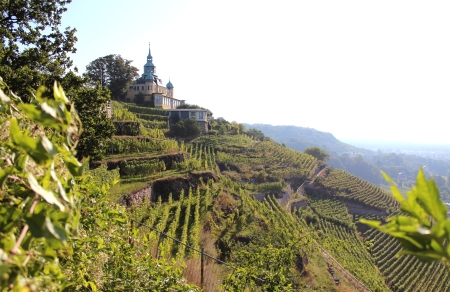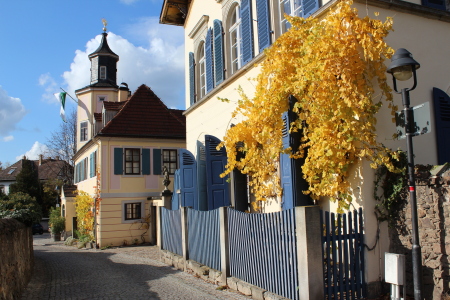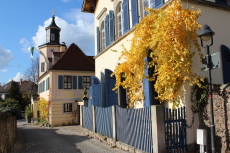Circular route 3 - Oberlößnitz
Follow the exit until you reach Kötzschenbrodaer Straße and turn right there. After approx. 100 metres, get into the left-hand turning lane. To continue, use the cycle path, cross the railway bridge and after approx. 100 m turn left into Weintraubenstraße. Here you cross Meißner Straße and see the Landesbühnen Sachsen building (see description of circular route 2). Stay on the right-hand side and pass Meißner Straße at the bus stop island to cycle uphill along Schuchstraße. At the top, cross Winzerstraße and Paradiesstraße and cycle downhill along An der Jägermühle. Turn right into the next street and cross the tracks of the narrow-gauge railway to the next junction. At this junction, continue straight on uphill to the next junction. A wonderful panorama immediately opens up before you. To your left is the Hoflößnitz Winery Museum (see description of circular route 2), and on the heights of the Lößnitz slopes you can see the Spitzhaus. It was built in the 1st half of the 17th century. It got its name from the tower-like spire. In 1710, the Spitzhaus came into the possession of the Wettin family and was then merged with the Hoflößnitz. The two houses were connected by the Spitzhaus staircase, which was built during the reign of Augustus the Strong. Daniel Pöppelmann designed this staircase. It is also popularly known as the "Jahrestreppe" because of the number of steps.
Before you continue your circular route, you should pay a visit to the Hoflößnitz (see description of circular route 2). Even if the path to the Spitzhaus and the Bismarck Tower via the Spitzhaus staircase is a little arduous, it is well worth it. You will be rewarded with a fantastic view over Radebeul, the valleys on the left bank of the Elbe, Dresden and, on a clear day, as far as the Ore Mountains and Saxon Switzerland. The staff at the Spitzhaus will be happy to look after your physical well-being. After a rest, descend back to Hoflößnitz and continue your journey by bike.
At the crossroads, take the narrow Weinbergstraße, which begins with the Meinholdschen Turmhaus, an estate that has been cultivated and built on since the 16th century. For 100 years, the Meinhold family characterised the country estate with their taste, which presents itself as a counterpart to Hoflößnitz Castle. Today, the historic wine estate is once again a household name as Weingut Aust. Friedrich Aust is continuing the tradition and revitalising the old winery.
If you continue up the idyllic road, you will see many old winegrowers' houses on the left-hand side. One of them is the Retzschgut. It includes a large vineyard where wine has been grown since 1649. It was named after the painter and professor at the Dresden Academy of Art, Moritz Retzsch, who lived in this house. The current owner still cultivates the vineyard and founded his own wine-growing business in 1992. He serves his own wines in a wine tavern.
A little further uphill, you will also see Haus Lorenz on the left-hand side. It was built there in the 17th century. Today it is only used for residential purposes.
A few metres further on, under the landmark of the Stone Snail, the crowning glory of the Radebeul Ballberg, you will come to the "Three Gentlemen" winery. Both are a part of Radebeul's and therefore Saxony's wine-growing history. Let the former Saxon wine queen initiate you into the secrets of Saxon wine.
At the end of Weinbergstraße, turn right into Eduard-Bilz-Straße and cross the first junction straight ahead. On this section of the street you will find many houses of the same architectural style, the so-called "Zillerhäuser". These houses were designed and built by the Radebeul-based master builders Gebrüder Ziller.
At the end of the street, turn right into Nizzastraße and continue straight on until you reach the roundabout, which you leave to the left and continue to the traffic lights.
Cross the junction and you will have direct visual contact with the Luther Church, for which the foundation stone was laid in 1891. The building was constructed in the neo-Renaissance style. The church was consecrated in 1892. To this day, structural changes and extensions have been made in and to the church. The church has borne its name since 1934.
Continue straight ahead and turn right at the next junction into Karl-May-Straße. The Karl May Museum is located on the right-hand side.
The literary-historical site, the writer's former home, Villa Shatterhand.", familiarises visitors with the eventful biography of Karl May (1842 to 1912), his literary works and his travels to the Orient and America.
The ethnological Indian collection housed in the Karl May Museum is one of the most valuable in Europe. The exhibition gives visitors a vivid insight into the cultures and lifestyles of the Indians of North America.
Now that you are richer in knowledge, you can complete circular route 3 in the direction of the Elbe. After leaving the exhibition, turn right and at the end of Karl-May-Straße turn left into Schumannstraße. At the end of the street, turn right into Pestalozzistraße. At the next junction, cross the tracks of the narrow-gauge railway on the left. You are now in Wasastrasse. When you reach a priority road after a while, continue straight ahead and cross Kötzschenbrodaer Straße. On the right-hand side, the former Serkowitz inn is now home to the Lügenmuseum. Continue into the village centre of Altserkowitz. At the end of the village green, you will reach the Elbe cycle path.
Details of the cycle route
| Distance: | 7 km |
|---|---|
| Duration: | 45 min |
| Height: | 53 |
| Difficulty: | leicht |












